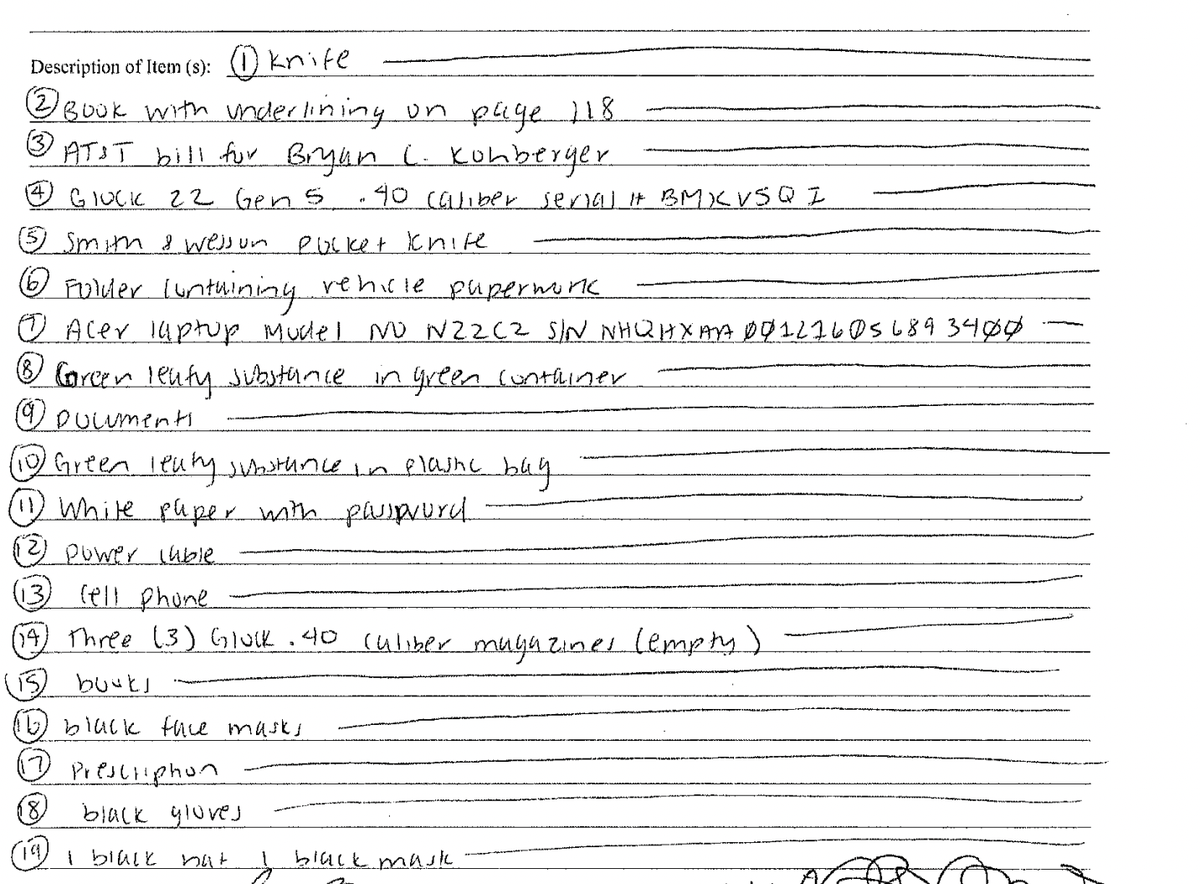Four students stabbed to death, a weeks-long manhunt and still no motive: What we know about the Idaho murders

The murder of four college students in the quiet town of Moscow, Idaho, last November unravelled a months-long investigation that is now headed to trial.
The victims, all students at the University of Idaho, were ambushed in their rooms and stabbed to death with a military-style knife that has yet to be found. Police were called to the gruesome scene at the off-campus residence almost eight hours after the vicious attack.
For weeks, only scant details about the carnage were revealed as the community reeled from the tragedy and grappled with fears of a murderer on the loose. That changed with the December arrest of Washington State University student Bryan Kohberger, whose apartment, office and family home were raided and searched for evidence.
While more information has become public through the release of search warrants and arrest records in recent months, a gag order in the case remains in place and most aspects of the probe and its findings are still a mystery.
In an unusual move on Monday (22 May), Mr Kohberger refused to enter a plea in Latah County District Court, prompting the judge to make one on his behalf.
As the case officially moves to trial, The Independent takes a deep dive into the developments in the complex case in the last six months:
How did the stabbings unfold?
Kaylee Goncalves, Madison Mogen, Xana Kernodle and Ethan Chapin were stabbed to death in the young women’s rental home on King Road in Moscow on 13 November. Chapin, Kernodle’s boyfriend, was staying at the residence, which is just a few minutes walk from campus, on the night of the murders.
According to an affidavit for Mr Kohberger’s arrest, the killings are believed to have taken place around 4am.
Among the revelations in the 18-page document is that Mr Kohberger’s DNA was found on a knife sheath that the killer left behind at the crime scene. The tan leather Kabar sheath, which featured the United States Marine Corps symbol, was discovered on Mogen’s bed next to her butchered body.
At the time of the quadruple homicide, the two other roommates, Bethany Funke and Dylan Mortenson, were inside the home, but were left unharmed by the killer. The police report reveals that Ms Mortenson came face to face with the masked killer.

According to Ms Mortenson’s terrifying account, she had gone to sleep in her bedroom on the second floor of the three-floor home and was woken by what sounded like Goncalves playing with her dog in one of the third-floor bedrooms.
She told investigators she was in her bedroom on the second floor of the home – the same floor where Kernodle and Chapin were killed – and was standing in the doorway as the killer walked right past her. A short time later, Ms Mortenson said that she heard someone believed to be either Goncalves or Kernodle saying, “There’s someone here”.
Minutes later, Ms Morterson. said that she looked out of her bedroom for the first time but did not see anything. She then opened her door for a second time when she heard what she thought was crying coming from Kernodle’s room, the documents state.
At that point, she said she heard a man’s voice saying, “It’s ok, I’m going to help you.”
When she opened her door for a third time minutes later, she said she saw “a figure clad in black clothing and a mask that covered the person’s mouth and nose walking towards her”. As she stood in a “frozen shock phase,” she said the man – who she did not recognise – walked past her and headed toward the back sliding glass door of the home. She then locked herself in her room.

Despite the close encounter, a 911 call wasn’t made until 11.58am – eight hours later. The call, made from one of the surviving roommates’ cellphones – reported an “unconscious individual”. It is unclear if the killer saw her or whether she simply had a lucky escape because he didn’t notice her inside the dark home.
This raises the question around whether or not he planned to kill all four victims or whether some of the victims were treated as collateral damage in the horrific attack. Goncalves and Mogen’s bodies were found in a bedroom on the third floor, while Kernodle and Chapin were found on the second floor of the home.
The affidavit reveals no details about what connection – if any – Mr Kohberger had to his alleged victims.
Mr Kohberger, a criminal justice PhD student at Washington State University, lived just 15 minutes from the victims over the Idaho-Washington border in Pullman, having moved there to begin the academic programme in August 2022.
Who are the victims?
Goncalves and Mogen, both 21, were seniors at the University of Idaho and were expected to graduate this year.
At a vigil weeks after the murders, Goncalves’ father Mr Goncalves told how the two “absolutely beautiful” young women first met in sixth grade and became inseparable.
“They just found each other and every day they did homework together, they came to our house together, they shared everything,” he said at the time. “Then they started looking at colleges, they came here together. They eventually get into the same apartment together.
“And in the end, they died together, in the same room, in the same bed.”

Kernodle and Chapin were juniors at the college and had begun dating months before their deaths. The couple of 20-year-olds is believed to have been awake at the time the stabbings were carried out.
Six months after the stabbings, the families of the slain students accepted posthumous awards for their achievements.
Mogen and Goncalves’ relatives walked across the stage for their degrees in an emotional ceremony on 13 May. Kernodle’s family also accepted her certificate in marketing at a separate ceremony while Chapin’s award in sports, recreation and management was mailed to his parents.
Kernodle’s family accepted her certificate in marketing at a private ceremony last week while Chapin’s award in sports, recreation and management will be mailed to his parents this week.

Who is Bryan Kohberger?
At the time of the murders, Mr Kohberger was studying for his PhD and working as a teaching assistant in criminal justice at WSU.
Prior to this, Mr Kohberger studied criminology at DeSales University first as an undergraduate and then finishing his graduate studies in June 2022.
According to online school records, Mr Kohberger received an associate arts degree in 2018 from Northampton Community College in Albrightsville and received a masters degree in criminal justice this year from DeSales University.

While studying at DeSales, he studied under renowned forensic psychologist Katherine Ramsland who interviewed the BTK serial killer and co-wrote the book Confession of a Serial Killer: The Untold Story of Dennis Rader, the BTK Killer with him.
He was working part-time as a security guard until August 2021 at Pleasant Valley School District, where his mother was listed as a paraprofessional.
The alleged murderer carried out a research project “to understand how emotions and psychological traits influence decision-making when committing a crime”.
Mr Kohberger reached out to potential participants on Reddit, with the chilling survey resurfacing after his arrest.
“In particular, this study seeks to understand the story behind your most recent criminal offense, with an emphasis on your thoughts and feelings throughout your experience,” the post said.
His fascination appears to have continued around the time of the murders when he applied for an internship with the local police department.
The affidavit revealed that he applied for an internship in the fall of 2022 with the Pullman Police Department and wrote in an essay how he had an interest “in assisting rural law enforcement agencies with how to better collect and analyze technological data in public safety operations”.
What the unsealed records reveal
After weeks of no updates on the investigation, law enforcement in Idaho and Pennsylvania announced Mr Kohberger’s arrest on 30 December. A search warrant was executed at Mr Kohberger’s apartment in Pullman, Washington, the same day he was arrested at his parents’ home in Pennsylvania.
A record of evidence recovered during the apartment search revealed the seizure of 15 items including hairs, receipts, a computer tower, a disposable glove and items with peculiar stains.
In the search warrant record, investigators list several items with stains, including cuttings of a mattress cover, a “reddish/brown” stain on an uncovered pillow and a “collection of dark red spot”. Dr Monte Miller, a former crime scene investigator and forensic expert, and former FBI agent Jennifer Coffindaffer told The Independent back in January that investigators most likely believed those items had blood stains.

“A reddish or brown stain is a euphemism for, ‘We found something that looks like blood,’” Dr Miller said at the time. “It might be blood from the victims, might be his blood. They don’t know until they test it, but they’ll be able to get DNA if it is blood. We don’t know what the stains in the cover sheets look like, but again they’re looking for any kind of DNA, evidence that might have come from the crime scene.”
Ms Coffindaffer added: “They don’t call it blood, but it’s definitely inferred that it was blood.”
Court documents, released by Washington authorities on 4 May showed that multiple items taken from Mr Kohberger’s apartment in Pullman had been tested for the presence of blood. While most items came back negative, two unspecified items were positive.

Another item included on the list of seizures was a “possible animal hair strand”. While Mr Kohberger is not believed to have a pet, one of the victims he is accused of killing, Goncalves, had a dog that was at home at the time of the murders and was later found by police responding to the scene.
“The possible animal hair they’ll try to connect that to the dog left at the scene,” according to Dr Miller. “If there’s a root on that, if there is any skin on that hair, they could do a DNA test with that dog. If it’s just a hair that’s been shed and there is no skin, they would still be able to do a microscopical comparison and exclude most dogs but they wouldn’t be able to connect it necessarily to that dog.”
Mr Kohberger was also linked to the crime through cellphone records and his white Hyundai Elantra, a similar model of the car seen near the murder home around the time of the murders. Mr Kohberger changed the license plates on his Hyundai Elantra just days after the murders.
The suspect’s car had Pennsylvania plates when it was pulled over by police in Moscow, in August 2022, according to a citation from the Latah County Sheriff’s Office. A review of documents on CarFax by Newsweek showed that Mr Kohberger changed the registration from Pennsylvania to Washington on 18 November, five days after four students were found stabbed to death in a Moscow home.
What we don’t know
No murder weapon has been found, police said before the gag order was issued following Mr Kohberger’s arrest.
It is not known if the killer personally knew one or more of the victims and whether the attack was carried out in a fit of jealousy or rage. No motive is known.
Authorities have refused to reveal who made the 911 call and will not release the audio. It is unclear what the roommates and “other friends” discussed in the call and what led them to describe a victim as merely “unconscious”.
Investigators have not revealed whether they believed the killer entered the house before the victims arrived home and hid before striking in their sleep or whether he entered the house after the students returned.
What comes next?
A preliminary hearing, where prosecutors had to show a judge that there is enough evidence to justify moving forward with charges of burglary and four counts of murder, was previously scheduled for 26 June.
However, on 16 May, a grand jury indicted Mr Kohberger on the same charges, effectively rerouting the case directly to the state’s felony court level and allowing prosecutors to skip the preliminary hearing process, the Associated Press reported.
On Monday 22 May, Mr Kohberger refused to enter a plea in Latah County District Court, with his attorney saying that he was “standing silent” on the charges.
The unusual response prompted the judge to enter a “not guilty” plea on Mr Kohberger’s behalf, setting the stage for a trial in which he could potentially face the death penalty.
According to the indictment, Mr Kohberger is charged with four counts of murder in the first degree and one count of burglary.
Each murder count states that he “did wilfully, unlawfully, deliberately, with premeditation and with malice aforethought, kill and murder” each of the victims by stabbing.
The list of witnesses who testified before the grand jury is sealed. Mr Kohberger’s indictment means that the jurors empanelled on the grand jury believed there was enough evidence against him for the case to proceed to trial.
Mr Kohberger said through a public defender earlier this year that he “was eager to be exonerated.”
He is being represented by Ann Taylor, one of thirteen public defence attorneys in the state who can work in cases where the prosecution requests capital punishment.
Prosecutors now have 90 days to enter a request to pursue the death penalty against Mr Kohberger.
The Judge has set Mr Kohberger’s trial date for 2 October 2023 following requests by Kohberger’s attorney and the state. The trial is expected to take around six weeks.
